Bellflower Blu-ray Movie
HomeBellflower Blu-ray Movie 
Blu-ray + DVDOscilloscope Pictures | 2011 | 106 min | Rated R | Nov 15, 2011
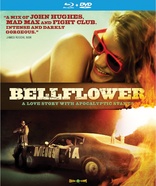
Movie rating
7.1 | / 10 |
Blu-ray rating
| Users | 0.0 | |
| Reviewer | 4.0 | |
| Overall | 4.0 |
Overview
Bellflower (2011)
Best friends Woodrow and Aiden spend all of their free time building MAD MAX-inspired flamethrowers and muscle cars in preparation for a global apocalypse. But when Woodrow meets a charismatic young woman and falls hard in love, he and Aiden quickly integrate into a new group of friends, setting off on a journey of love and hate, betrayal, infidelity, and extreme violence more devastating and fiery than any of their apocalyptic fantasies.
Starring: Evan Glodell, Jessie Wiseman, Tyler Dawson, Rebekah Brandes, Vincent GrashawDirector: Evan Glodell
| Drama | Uncertain |
| Romance | Uncertain |
| Action | Uncertain |
Specifications
Video
Video codec: MPEG-4 AVC
Video resolution: 1080p
Aspect ratio: 2.39:1
Original aspect ratio: 2.39:1
Audio
English: DTS-HD Master Audio 5.1 (48kHz, 24-bit)
English: LPCM 2.0
Subtitles
English SDH
Discs
50GB Blu-ray Disc
Two-disc set (1 BD, 1 DVD)
DVD copy
Packaging
Slipcover in original pressing
Playback
Region free
Review
Rating summary
| Movie | 4.5 | |
| Video | 4.0 | |
| Audio | 4.0 | |
| Extras | 4.0 | |
| Overall | 4.0 |
Bellflower Blu-ray Movie Review
Into Every Life, A Little Apocalypse Must Erupt
Reviewed by Michael Reuben November 12, 2011Does this sound familiar? A young writer-director makes a low-budget first feature about troubled romantic relationships, because fledgling storytellers are advised to "write what you know". The film is obviously autobiographical, and even if it's well-made, it has a "been there, done that" quality, because -- let's face it -- many young filmmakers are college-educated and upper middle class, and their experiences aren't that dissimilar. (Exhibit A: Happythankyoumoreplease.) Then there are the films that don't work, because the beginning artist is ambitious but doesn't yet have the skill to bring off something original; he probably needs the kind of apprenticeship that directors used to get from TV or Roger Corman before tackling his own story. (Exhibit B: Ceremony.) Occasionally, though, something comes along that so radically violates expectations of what a debut coming-of-age film can accomplish that all you can do is stop, stare and ask yourself: What is this? I hereby present an Exhibit so bizarre that no letter in the alphabet does it justice: Bellflower, from writer, director, co-producer, co-editor and star Evan Glodell and his production company of friends and co-conspirators known as "Coatwolf". As far as I know, it's the only film ever to tour the arthouse circuit accompanied by a fully functional muscle car (featured in the film) that's been specially built to resemble the vehicle driven by Mad Max in The Road Warrior -- with added rear-firing flamethrowers that work.
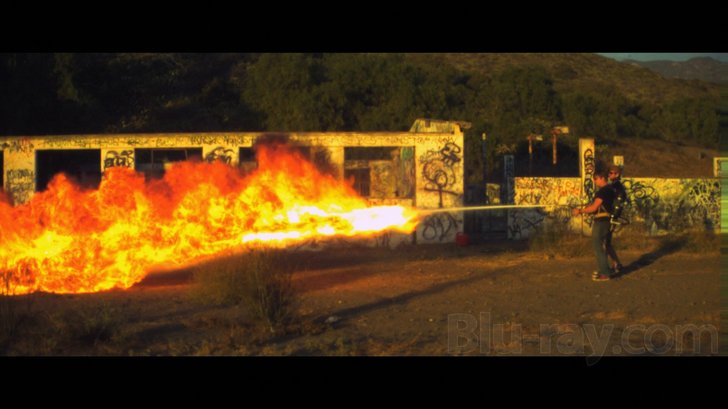
Woodrow (Glodell) and Aiden (Tyler Dawson) are long-time best friends who moved from their native Wisconsin to an unnamed town in California, because they thought it would be cool. It isn't. The California they inhabit lacks the glamorous, pop-culture attraction of L.A. or San Francisco (or even their suburbs), nor does it possess the romantic natural allure of redwood forests, the Pacific Coast Highway or the Santa Cruz Mountains. It's just one of the many pre-fab, hurriedly erected eyesore towns that dot the Golden State, crumbling around the blue collar and immigrant inhabitants. Bellflower is the name of the street on which Woodrow lives. (The film was shot in Oxnard and Ventura.) Woodrow and Aiden share a passion, which is the film originally called Mad Max 2 and best known here as The Road Warrior. But the figure they most admire from the film isn't Mel Gibson's Max; it's his ultimate opponent, the Humungous (a/k/a The Lord Humungous, the Warrior of the Wasteland, the Ayatollah of Rock 'n' Rolla). Exactly why Woodrow and Aiden are attracted to the Humungous, who's the villain of Road Warrior, is something worth pondering, and there's explanation in the dialogue if you listen carefully. But isn't the villain always more interesting? The two friends spend all their spare time and every available dollar (and then some) rebuilding Woodrow's car to resemble Max's V-8 interceptor, complete with two exhaust pipes rising from the trunk that can emit flames on command. They're also working on their own enhancement, a portable flame thrower, because they can imagine nothing cooler than tooling up to some group of strangers in Mad Max's car, only to emerge armed with a weapon from which a geyser of liquid fire erupts at will. It's never entirely clear what motivates Woodrow and Aiden to pursue these preparations. Are they expecting an actual "pocky-clypse", like the one that preceded Road Warrior? Or are they just two avid fans who happen to be building WMDs instead of intricate costumes for Comic-Con? As it turns out, a form of apocalypse does arrive for Woodrow. Her name is Milly (Jessie Wiseman). She and Woodrow meet in a bar one night when they're both there with friends and volunteer for a live cricket-eating contest. How's that for meet uncute? They click well enough to arrange dinner the following night. On an impulse (really, almost a shared dare), they drive all the way to a truck stop in Texas and are gone for several days, worrying everyone they know, including Aiden, Courtney (Rebekah Brandes), who is Milly's best friend, and Milly's roommate Mike (Vincent Grashaw), who's chiefly annoyed because Milly didn't get around to paying the rent before she vanished. During their absence, Woodrow initiates Milly into the intricacies of his and Aiden's plans and gives her a tour of the enhancements they're planning to his car, which they call "the Medusa". When they return, Woodrow and Milly are a couple, or at least Woodrow thinks so. From the outset, she warns him that she doesn't want a boyfriend and she'll hurt him. Before long she does just that, and both Woodrow and the film undergo a radical transformation. Like Max in the Mad Max series, Woodrow is injured (I'll leave the details for the viewer to discover). As he recovers, both his look and his demeanor change. All vestiges of the cheerful personality we initially encountered vanish, and a hollowed-out individual emerges, angry at the world and sickened by everything he sees. A rebound relationship gives him no comfort, and when Aiden can't get his old friend back to normal, he does the only thing he can imagine, which is to go off and try to finish the Medusa on his own. Glodell has already tinkered with the linear narrative by this point; the film's opening is a flash forward, and Woodrow's road trip with Milly contains a non-chronological montage that prompted someone to submit a "goof" to IMDb (which it isn't). But in this latter part of the film, the editing is purposely disorienting, as Woodrow's inner world becomes indistinguishable from reality. When Aiden proudly presents Woodrow with the completed Medusa, it's almost inevitable that the powerful machine will soon come barreling up to Milly's door. Indeed, Milly herself seems to go out of her way to provoke her ex into coming after her, and the film's most unsettling scene has Woodrow blazing into her kitchen and demanding satisfaction in a violent and bloody confrontation. Or does he? As Woodrow and Aiden discuss their future plans in voiceover at the end of the film, it's not entirely clear what did and didn't happen. All we know for sure is that powerful emotions have swept over these California back alleys, like the 75-foot plume of fire emitted from the flamethrower these two friends managed to construct -- and something got burned. Glodell doesn't write standard movie dialogue, and he doesn't shape scenes in a conventional manner. One's first reaction might be to group him with so-called "mumblecore" filmmakers, because his characters look and sound ordinary and speak in everyday banalities and repetitions. This may try the patience of viewers used to more traditional screenwriting (and it's ironic, really, because Glodell's dialogue is far more realistic than what typically passes for realism in film). But there's a method to Glodell's mundaneness, and if you stick with it, it draws you into something truly dark, obsessive and unsettling precisely because it feels so real. It's a place not usually associated with mumblecore. These are ordinary people, but they're the kind who could end up on the six o'clock news, with a neatly manicured reporter standing out front, clucking over the senseless tragedy of it all. Such nice young folks; what could have caused this?
Bellflower Blu-ray Movie, Video Quality 
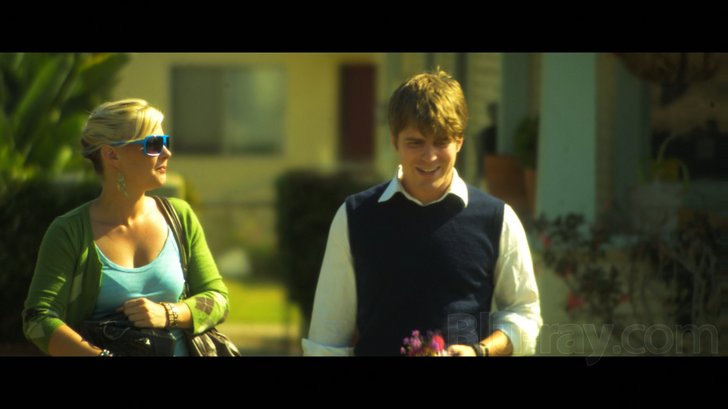
In the true do-it-yourself spirit of independent film, writer-director, etc. Evan Glodell also built the digital camera used to shoot Bellflower, a Silicon Imaging SI-2K Mini Digital camera outfitted with vintage parts and Russian lenses. Glodell christened the finished product the "Coatwolf Model II", and the result is unlike any digital image I've ever seen. It has no hard edges or harshness to it; indeed, at first blush, one might be pardoned for thinking that Bellflower was shot on consumer grade DV. But as you look more closely, you begin to realize that the frame has more detail and objects are much better defined that has ever been possible with consumer DV. More importantly, colors are stronger, and the image is able to handle sudden, strong contrasts, like the crucial bursts of flame from the home-made flamethrower (which the production company built for real). Blacks are actually black, and none of the artifacting typically seen in low-resolution digital cinematography is anywhere to be found. In short, what Glodell has achieved is the illusion of a grungy look without compromising the quality of his image. There is, however, a pervasive oddity for which I cannot account. In shot after shot, large flecks of dirt and/or smears of grime appear on the camera lens. Since Bellflower was made by an auteur sufficiently intense to build his own camera and with digital cinematography that would allow instantaneous review of every take, it's impossible to believe that this was accidental, especially since the "dirty lens" phenomenon recurs throughout the film. I'm therefore forced to conclude that it's some sort of visual device intended to complement the dry, dirty locale and, perhaps, comment on the messy lives of the characters in their metaphorical Mad Max wasteland. For my money, it's a distraction and would have been better omitted. In any case, as a reviewer I'm obliged to report it. Oscilloscope Labs has used a BD-50; so compression errors are not an issue. I wasn't able to see Bellflower theatrically, because it hasn't played at a theater in New York City, as of the date of this review. However, as is typically the case with Blu-rays sourced from films acquired digitally and/or finished on a digital intermediate, one can proceed with a high degree of confidence that what appears on the disc matches the theatrical presentation.
Bellflower Blu-ray Movie, Audio Quality 

The DTS lossless track for Bellflower is dominated by dialogue, which is always clear, but that doesn't mean it lacks sophisticated sound editing. Glodell understands the virtue of using sudden shifts in sound, whether from volume to silence or vice versa, to punctuate drama and emphasize emotional states. When your story includes elements like muscle cars and flamethrowers, these are rich elements to play with. The mix also gets effective atmosphere out of situations like freeway driving or the bar where Milly and Woodrow meet, and in some instances sounds aren't tied to any source cue but evoke a state of mind, especially in the latter half of the film. There are several moody and appropriate "garage band" songs by the film's editor, Jonathan Keevil, which Glodell claims he just happened to stumble across during the editing process, and they blend well with the more traditional underscoring credited to Kevin MacLeod.
Bellflower Blu-ray Movie, Special Features and Extras 
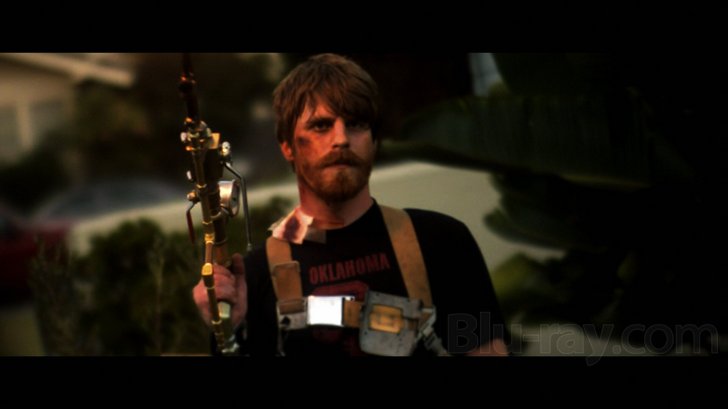
- Behind the Scenes of Bellflower (HD; various; 23:42): Glodell and the cast and crew (many of whom overlap) relate the history of the film, from its initial concept through its acceptance into the 2011 Sundance Film Festival. The documentary includes outtakes, on-set footage, a scene of the Medusa car's "christening" that almost could have been part of the film and "home movies" of the cast in Park City, Utah, looking like they can't believe what's happening.
- Medusa Rundown (HD; 1.85:1; 10:10): Glodell provides a detailed tour of the Medusa car in its final form, which wasn't completed until after Bellflower was sold to a distributor and Glodell's comany could afford some of the finishing touches (e.g., a genuine turbo-charge unit). Glodell's presentation is worthy of Q in a Bond film.
- Outtakes (HD; 2:35:1; 7:58): When you're working with a cast and crew composed of friends, informality is an essential part of the process. When you're working with no budget, improvisation is essential (watch the actors use clapping hands in place of slates). When you want realism, you do it the old-fashioned way; watch Glodell stick his fingers down his throat (repeatedly) for a scene where Woodrow throws up, and watch the Medusa car catch on fire.
- Original Theatrical Trailer (HD; 2.35:1; 2:03): Thematically, the trailer fairly represents the film, but it promises something faster paced than Bellflower's deliberate rhythms and purposeful meandering.
- Oscilloscope Releases (SD, except where noted): In a separate section, the disc contains trailers and one-sheet images for The Law, Terribly Happy (HD), Beautiful Losers, Exit Through the Gift Shop and Rare Exports: A Christmas Tale (U.S. red-band trailer) (HD).
- Credits: Presented as a barely concealed "easter egg", the disc's credits can be found by continuing to move the cursor to the right after the trailer on the extra features list. (On the DVD, click on the hand grenade image that illuminates when the cursor is moved to the left of the word "main" at the top of the extra features screen.)
Bellflower Blu-ray Movie, Overall Score and Recommendation 
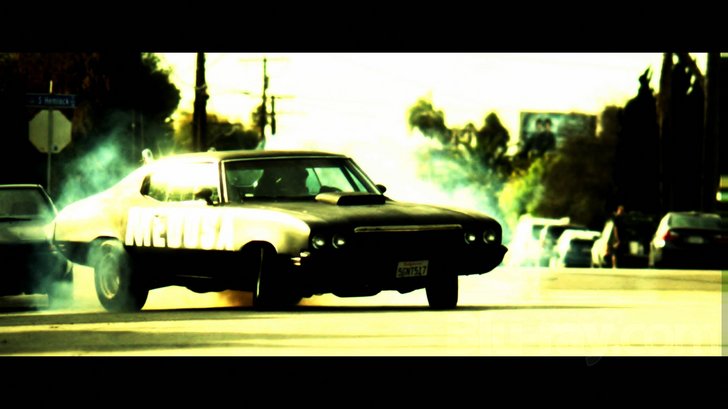
Bellflower gets under your skin. As little as I have in common with Woodrow and Aiden, watching their story unfold prompted me to recall feelings and experiences I hadn't thought about in years. Glodell has said that the initial germ of the film was his own experience of a break-up. Somehow he's found a way to externalize the heartache of that experience into narrative format that doesn't rely on anything we've seen before, and that's no small accomplishment. Bellflower may not be your idea of a good time, but I highly recommend it.
Similar titles
Similar titles you might also like

The Disappearance of Eleanor Rigby
Includes "Him", "Her", and "Them" Cuts
2014

The Social Network
Collector's Edition
2010

Her
2013

44 Inch Chest
2009

Blue Valentine
2010

Lost in Translation
2003

The Ticket
2016

My Blueberry Nights
2007

(500) Days of Summer
2009

Querelle
1982

Paris, Texas 4K
1984

Paterson
2016

Frank & Lola
2016

Listen Up Philip
2014

Song to Song
2017

The Rover
2014

Submarine
2010

Accident
1967

Young Ones
2014

The Master
2012
